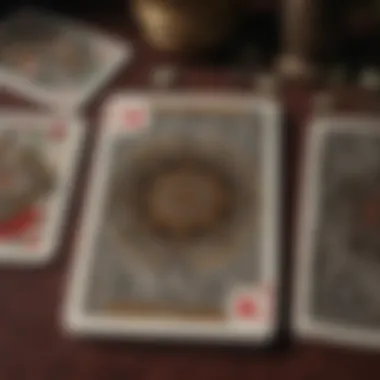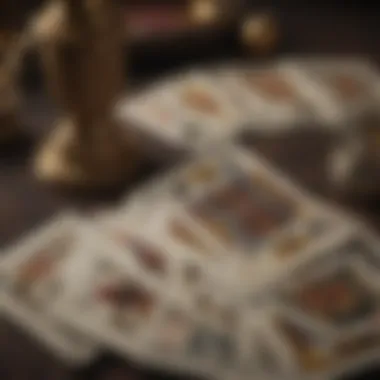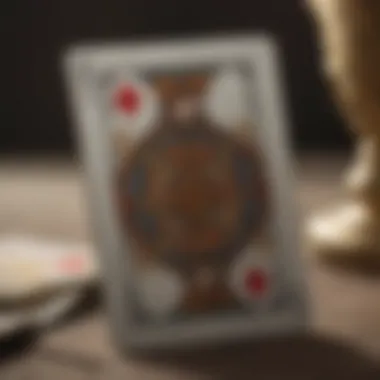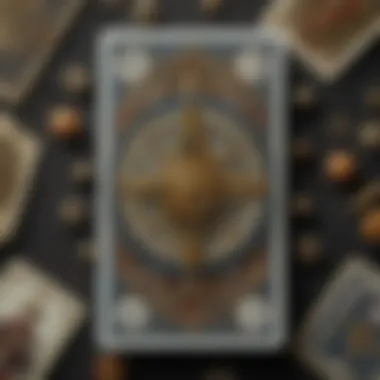Unlocking the Secrets of Tarot with Playing Cards


Intro
Tarot reading using playing cards is an intriguing practice that intertwines the meaning of traditional tarot with the familiar symbols found in a standard deck. This guide provides a comprehensive exploration of how these two systems relate. For both novices and experienced card readers, understanding the depth of these connections can enhance your card reading effectiveness. We will dive into card meanings, symbols, and practical applications, making it accessible to everyone seeking insight into tarot and playing cards.
Understanding the Zodiac
While the article's focus is primarily on tarot and playing cards, comprehending the Zodiac offers significant context to the overall experience of card readings. Astrology and tarot often influence each other, creating layers of meaning that enrich interpretations.
Overview of Zodiac Signs
The Zodiac comprises twelve signs, each representing distinct traits and characteristics. Understanding these signs can help provide background when interpreting card readings, particularly when discussing personality and influence.
Sign Traits and Characteristics
Each Zodiac sign carries specific attributes. For example:
- Aries: Bold and adventurous
- Taurus: Stable and determined
- Gemini: Adaptable and curious
- Cancer: Nurturing and emotional
- Leo: Confident and expressive
- Virgo: Analytical and practical
These traits can mirror the characteristics of certain cards during readings, enriching one's insight into the tarot experience.
Elemental Qualities
Every Zodiac sign is associated with one of the four elemental qualities: fire, earth, air, and water. These elements provide deeper understanding.
- Fire: Represents passion and action
- Earth: Connects to stability and material concerns
- Air: Symbolizes intellect and communication
- Water: Relates to emotions and intuition
These associations can enhance readings, as card meanings may align with elemental influences.
Tarot Basics
Understanding the fundamental differences between tarot cards and playing cards is essential. Traditional tarot decks consist of 78 cards, while standard playing card decks have only 52. Nonetheless, each suit in playing cards corresponds to the four suits in tarot and carries its unique significance.
Card Associations
- Hearts: Align with Cups, representing emotions and relationships.
- Diamonds: Correspond to Pentacles, indicating material aspects and security.
- Clubs: Reflect Wands, relating to action and creativity.
- Spades: Parallel Swords, linked to conflict and intellect.
Knowing these associations helps in transposing traditional tarot meanings onto playing card readings.
Practical Application in Readings
When utilizing playing cards in tarot readings, the real power lies in understanding card combinations and sequences. This aspect can lead to richer interpretations and more insightful revelations.
Insightful Combinations
Combining two or more cards can yield nuanced perspectives. For example:
- A Heart followed by a Club may suggest emotional creativity.
- A Spade next to a Diamond could indicate conflict regarding material matters.
Daily Card Pulls
A practical use of playing cards is performing daily card pulls. This ritual helps establish a habit of reflection and deeper understanding of one's daily experiences. In this, simple acts can lead to profound insights and guidance.
Preface to Tarot Reading with Playing Cards
Exploring tarot reading utilizing standard playing cards is a subject of emerging interest. This approach offers deeper insights into the art of divination, allowing practitioners to engage with familiar tools. This article aims to elucidate the methods, meanings, and historical context that enrich the practice of tarot with playing cards so that individuals, both novice and experienced, can gain from it.


Defining Tarot Reading
Tarot reading is a method of divination where the reader interprets cards to gain insights into the past, present, and potential futures. While traditional tarot decks often consist of 78 cards, including the Major and Minor Arcana, using playing cards shifts this paradigm. The approach provides a simplified structure that resonates with many practitioners. Readers learn to apply the meanings of specific cards to situations, helping clients uncover layers of their experiences.
Key aspects of tarot reading include:
- Intuition: Effective readings rely on the reader's gut feelings and perceptions.
- Symbolism: Each card has inherent meanings and connections that guide interpretation.
- Contextual Relevance: The surroundings during a reading can influence interpretations significantly.
Understanding these components provides a solid foundation for effective tarot reading.
The Historical Context of Playing Cards
The lineage of playing cards is both rich and complex. Originating in China during the Tang Dynasty, they spread across Europe in the late 14th century. Initially, these cards served various purposes, including gaming and fortune-telling. The suit system of playing cards, similar to tarot, evolved through different cultures, from the Italian tarocchi to the modern French deck.
Throughout history, playing cards have been perceived with mystery. They were often linked to gambling, which led to societal skepticism. However, their use in divination reflects an enduring fascination with uncovering hidden truths.
Playing cards typically consist of four suits:
- Hearts
- Diamonds
- Clubs
- Spades
This simple structure allows for diverse interpretations. Each suit encompasses meanings relevant to human experiences, such as emotion, wealth, action, and conflict. Understanding this context enhances the ability to integrate playing cards into tarot readings meaningfully.
The Framework of Card Meanings
Understanding the framework of card meanings is essential when delving into tarot reading with playing cards. Each card carries distinct symbolism that can guide interpretations. This framework establishes a basis for the relationships between card meanings and various aspects of life. Consequently, it allows both novices and seasoned practitioners to navigate readings with a sense of clarity and insight.
Understanding the Structure of Playing Cards
Playing cards possess an inherent structure, typically characterized by four suits: diamonds, hearts, clubs, and spades. Each suit not only conveys unique themes but also complements the overall reading experience. The orderly nature of playing cards enhances the reader's ability to make connections between different cards and their collective meaning. Notably, understanding this structure can aid in enhancing intuitive responses during readings. This intuitive aspect is vital, as it transforms card meanings into actionable insights, inspiring deeper reflection.
The Suit System and Its Interpretation
The suit system is pivotal in the interpretation of cards, as it categorizes cards based on their symbolic representation. Each suit contributes specific themes relevant to various life aspects. By exploring these suits, readers unveil deeper understandings of the cards.
Diamonds: The Suit of Wealth and Achievement
Diamonds are associated with wealth and achievement. This suit highlights material success, ambitions, and personal growth. Its core characteristic lies in its focus on tangible rewards and professional aspirations. Diamonds appeal to readers seeking clarity around financial and career matters.
The unique feature of diamonds is their representation of prosperity. In readings, they often indicate opportunities for advancement. However, one must consider the potential downside—an overemphasis on material gain could lead to neglecting emotional or spiritual needs. Thus, diamonds offer a balance, showing that while achievement is important, it should not overshadow other life aspects.
Hearts: The Suit of Emotion and Relationships
Hearts embody emotion and relationships, presenting a different angle of the tarot experience. This suit emphasizes the significance of personal connections, love, and emotional well-being. Its key aspect is the nurturing of interpersonal bonds, making it crucial for readers focused on emotional guidance.
The distinct feature of hearts lies in their emphasis on harmony and compassion. In card readings, hearts frequently signal clarity in personal relationships or emotional dilemmas. The challenge with hearts may arise when emotions become overwhelming, potentially clouding judgment. Still, their focus on relationships and harmony makes them an invaluable aspect of card readings, encouraging deep introspection.
Clubs: The Suit of Action and Ambition
Clubs signify action and ambition, positioning themselves as a driving force within card interpretations. This suit is particularly popular among those who seek motivation or need to assess their ambitions. Clubs highlight determination and the pursuit of goals, contributing an energetic tone to readings.
They excel in illustrating proactive measures toward achieving desires. Clubs encourage readers to take initiative and seize opportunities. However, withholding energy or acting impulsively can lead to obstacles. Therefore, practitioners must remain mindful of the need for balance between ambition and patience when interpreting clubs.
Spades: The Suit of Challenges and Conflict
Spades represent challenges and conflict, portraying the inevitable struggles individuals face in life. This suit brings to light obstacles that may require confrontation or reflection. Its central theme revolves around resilience and overcoming adversity, adding depth to the reading process.
One key characteristic of spades is their connection to introspection, as they often signify growth through hardship. In readings, spades can indicate crucial lessons learned. However, the unique feature lies in their potential to evoke discomfort. They serve as reminders that conflict, albeit challenging, is often a precursor to personal evolution. Embracing these lessons can elevate the overall understanding of a reading.


The framework of card meanings provides a foundation for interpreting various aspects of life. Understanding each suit's characteristics enhances a reader's insight into personal and collective journeys.
Card Meanings and Their Interpretations
The study of card meanings and their interpretations is a fundamental aspect of tarot reading with playing cards. Understanding the nuances of each card can enhance a practitioner’s ability to provide insightful readings. This section explores the different categories of cards, their meanings, and how the combinations can provide deeper insights into various life situations.
Major Arcana vs.
Minor Arcana
Defining the Major Arcana
The Major Arcana represents significant life events or themes. Each of the 22 cards carries profound symbolic meanings that reflect a person's journey. Not only are these cards essential in structuring readings, but they can also provide insights into major influences in one’s life. The key characteristic of the Major Arcana is its concentration on life-defining moments. This makes it a popular choice for individuals looking to gain clarity about profound existential questions. Its unique feature lies in the depth of interpretation each card offers, such as The Fool representing new beginnings and The World symbolizing completion and fulfillment. However, one potential disadvantage of focusing solely on Major Arcana is that it may overlook everyday interactions and experiences, which are equally important in a reading.
Examining the Minor Arcana
The Minor Arcana deals with daily events and experiences. It comprises 56 cards that are divided into four suits: Cups, Pentacles, Swords, and Wands. Each suit offers a different perspective, tackling elements of emotion, finance, conflict, and ambition. The key characteristic of the Minor Arcana is its emphasis on the mundane, mundane. This makes it a valuable choice for those seeking advice on immediate or everyday challenges. A unique aspect of the Minor Arcana is its representation of numerical progression, allowing for interpretations based on the number of cards drawn in each suit. However, its broader focus can sometimes lead to vague interpretations, as individual cards might not carry the same weight as those in the Major Arcana.
Playing Card Symbols and Their Meanings
Interpretations of Kings, Queens, and Jacks
In the realm of playing cards, Kings, Queens, and Jacks symbolize various qualities and attributes in a reading. Typically, these face cards represent specific types of people or energies relating to a person's life. The King often embodies authority or mature male influence, while the Queen represents nurturing or mature female energy. The Jack, usually marked by youthful vigor, brings a sense of potential and ambition. This aspect is crucial because it adds a layer of character analysis to readings. The advantage of focusing on these face cards is their capacity to signify relationships and interpersonal dynamics. However, interpretations can sometimes become overly complex when many face cards appear in a single reading.
Numerical Values and Symbolic Interpretations
Numerical values in card readings provide a systematic way to enhance their meanings. Each number from one to ten has its connotations that can enrich a reading. For instance, the number three can represent creativity and collaboration, while five might signify conflict or change. This aspect contributes to the overall interpretation by allowing practitioners to gauge not only individual card meanings but also the energy dynamics represented through numbers. The benefit of focusing on numerical values is the ability to create a more rounded and layered understanding of card combinations. However, novices might overlook these subtleties, leading to simplistic interpretations.
The combination of card meanings and their numerical interpretations can open up extensive possibilities for understanding life’s complexities.
In summary, grasping the meanings behind both Major and Minor Arcana, as well as understanding the significance of face cards and numerical values, is essential for anyone delving into tarot reading with playing cards. Whether one seeks profound guidance through the Major Arcana or practical insights through the Minor Arcana, each element contributes to the rich tapestry of interpretations available to practitioners.
Practical Applications of Card Readings
The practical applications of card readings establish a cornerstone for understanding tarot reading with playing cards. This segment is crucial as it bridges theory and practice. Engaging in real-life applications enhances the relevancy of card interpretations, allowing practitioners to apply insights gained from readings to their daily lives. By articulating how various spreads and combinations can be utilized, one gains not only confidence but also clarity in navigating personal challenges and decisions.
Common Spreads Used in Readings
The Three-Card Spread
The Three-Card Spread is a favored method among practitioners for its simplicity and effectiveness. Typically, it involves drawing three cards representing past, present, and future. This straightforward approach enables readers to identify themes and patterns in a succinct manner. Its popularity arises from the detailed but concise information it provides, which can be beneficial for both novice and experienced readers.
One unique feature of the Three-Card Spread is the depth it offers with just three cards. Each card’s position carries specific meanings related to its temporal context—past influences, current situations, and future potentials. However, while the spread is accessible, it requires a nuanced understanding of card combinations to extract a well-rounded interpretation. In essence, it’s an ideal choice for those seeking clarity without being overwhelmed by complexity.
The Cross Spread
The Cross Spread presents a more intricate analysis compared to the Three-Card Spread. It typically consists of five cards placed in a cross formation, delving deeper into the seeker’s situation by providing insights into obstacles and influences. This method allows for a multidimensional look at the circumstances surrounding a query, offering significant potential for revealing hidden aspects that may not be obvious.
The key characteristic of the Cross Spread is its ability to highlight conflicts and resolutions, making it an invaluable tool for those facing challenging decisions. Its comprehensive nature is both a strength and a weakness; while it draws a more elaborate picture, it can also lead to interpretation paralysis due to the abundance of information. Therefore, it is recommended for readers who are comfortable with longer readings and can manage the complexity of insights.
The Celtic Cross Spread
The Celtic Cross Spread stands out as one of the most iconic tarot spreads, widely recognized among practitioners. It employs a total of ten cards, each with distinct placements that narrate a storyline about the seeker’s journey. Given its detailed structure, it is designed to address a multitude of areas such as motivations, fears, and external influences—a comprehensive view into one’s life path.
A notable aspect of the Celtic Cross Spread is its in-depth exploration of a topic, providing context and laying out potential outcomes. This depth can help the querent gain perspective on long-term issues or complex situations. Nonetheless, the complexity associated with interpreting the sheer volume of cards can be daunting for newcomers to tarot. Thus, it often serves as a preferred option for seasoned practitioners who appreciate the nuances that come with a detailed exploration of life’s many facets.
Interpreting Card Combinations


Interpreting card combinations is an essential skill that significantly enriches the tarot reading experience. Individual card meanings can shift dramatically when considered in relation to each other. Therefore, understanding the synergy between cards allows for a more profound interpretation of their collective messages. By developing this interpretative skill, practitioners can unlock deeper insights and more personalized guidance. Regular practice with card combinations can enhance one's intuition, leading to more meaningful tarot readings.
Enhancing Your Tarot Practice
Enhancing your tarot practice is crucial for anyone looking to deepen their understanding and effectiveness in tarot reading using playing cards. It involves tapping into one's intuition, refining interpretative skills, and utilizing various resources. This enhancement not only allows for a richer experience for the reader but also offers more profound insights to those seeking guidance.
Developing Intuition and Interpretation Skills
Intuition plays a vital role in tarot reading, especially when using playing cards. Developing this skill can transform your approach from merely memorizing meanings to genuinely interpreting what the cards convey in each unique situation.
- Practice Regularly: Frequent readings help attune your intuitive senses. The more you engage with the cards, the more you learn how to interpret them instinctively.
- Journaling: Keep a record of your readings. Document the context of the reading, your thought process, and the interpretations. Over time, patterns will emerge that can aid future readings.
- Meditation: Spend time in quiet reflection before a reading. This practice can clear your mind and allow your intuition to surface, enhancing the depth of your insights.
Developing these intuition and interpretation skills is not a rapid process but a gradual journey, rewarding those committed to it.
Tools and Resources for Tarot Reading
Numerous tools and resources can complement your tarot practice. They provide guidance, enhance knowledge, and foster community among practitioners. Exploring these can greatly benefit your development.
Books and Literature
Books and literature about tarot reading are foundational resources for both novices and experienced readers. They offer a wealth of information, covering everything from basic meanings to advanced interpretive techniques. The breadth of perspectives in these texts allows readers to gain a well-rounded view of tarot concepts.
- Key Characteristics: Many books provide in-depth analysis of each card, outlining various interpretations and insights into historical contexts.
- Benefit: They serve as comprehensive references individuals can return to repeatedly.
- Unique Features: Certain texts might include exercises or case studies that enhance self-learning.
- Advantages: The information is often more detailed than what is found online.
- Disadvantages: There can be a wide disparity in quality and perspective among available texts.
Online Platforms and Communities
Engaging with online platforms and communities can significantly enrich your tarot practice. These spaces foster interaction, allow for sharing experiences, and provide opportunities for collaboration.
- Key Characteristic: Many websites, forums, and social media groups focus on tarot discussions, enabling readers to interact.
- Benefit: These platforms offer a mix of diverse interpretations and experiences from a global audience, broadening one’s perspective.
- Unique Features: Resources such as Reddit or dedicated Facebook groups often provide real-time feedback and support for specific questions.
- Advantages: Instant access to a multitude of viewpoints enriches learning.
- Disadvantages: With a vast array of information available, it can sometimes lead to confusion or conflicting advice.
Engaging regularly with resources will foster personal growth and deepen your understanding of tarot reading.
The Spiritual Aspect of Card Reading
The realm of tarot reading transcends mere card interpretation. It embodies a spiritual journey, a bridge connecting the tangible and intangible dimensions of existence. This section delves into why understanding the spiritual aspect of card reading is crucial for both practitioners and seekers.
Connecting with Higher Self Through Cards
Establishing a connection with one’s higher self is a foundational component of tarot reading. Cards serve as vessels for intuitive guidance, enabling individuals to tap into deeper insights about their life and experiences. Engaging with playing cards can reveal subconscious patterns and facilitate self-reflection. The imagery on the cards often resonates with personal experiences, creating a dialogue between the reader’s inner thoughts and the external symbols.
This connection fosters a greater sense of self-awareness. Many readers find that as they progress in their practice, the cards offer clarity, highlighting truths that introspection alone might miss. This enhanced awareness often leads to personal growth, enabling individuals to navigate their paths more wisely. Practicing mindfulness during readings can strengthen this connection.
The Role of Intention in Readings
Intention plays a vital role in tarot readings. Setting a clear intention before a session can greatly influence the outcome. A well-defined question or focus point primes the cards to resonate with specific energies. This practice cultivates a mindset that aligns with receiving relevant guidance, making the reading not just about the cards, but about the seeker’s quest for knowledge.
Furthermore, intention can shape the overall atmosphere of the reading. A calm, focused environment enhances receptivity. Many practitioners employ rituals, such as lighting candles or meditating, to center themselves and clarify their intentions. This commitment to the process elevates the significance of the reading, transforming it into a sacred act.
Closure and Future Insights
The exploration of tarot reading using playing cards reveals much about the craft and the practitioners. Understanding the evolution of these practices is essential not just for scholars but for anyone interested in integrating this ancient art into contemporary life. This section emphasizes the importance of evolution in tarot reading, illustrating how historical shifts have influenced modern interpretations and applications.
The Evolution of Tarot Reading
The journey of tarot reading with playing cards began centuries ago. Initially, tarot carried deep mystical connections, often enveloped in the esoteric traditions of its time. As these cards crossed cultures and experienced various adaptations, their meanings transformed subtly, reflecting the values and beliefs of different societies. Today, practitioners can find a blend of traditional approaches coexisting with modern reinterpretations. This evolution showcases a vibrant dialogue between past and present.
Furthermore, tarot reading has adapted to modern technology. Online platforms provide avenues for learning and practicing tarot techniques with playing cards, allowing both beginners and seasoned readers to connect globally. The accessibility of resources is a clear marker of evolution, leading to expanded communities and greater sharing of insights.
Encouragement for Continued Exploration
Tarot reading should not be seen as a finite practice, but rather as an evolving journey. The guide emphasizes that readers should actively engage with their intuition, explore various works, and connect with fellow enthusiasts. Each reading can bring new perspectives, and every card holds significance beyond initial interpretations.
Readers are encouraged to explore diverse resources, from books to online discussions, enhancing their understanding and enriching their experience. Community interaction, such as online forums or social media groups, has become invaluable for sharing unique interpretations, asking questions, and receiving support.







